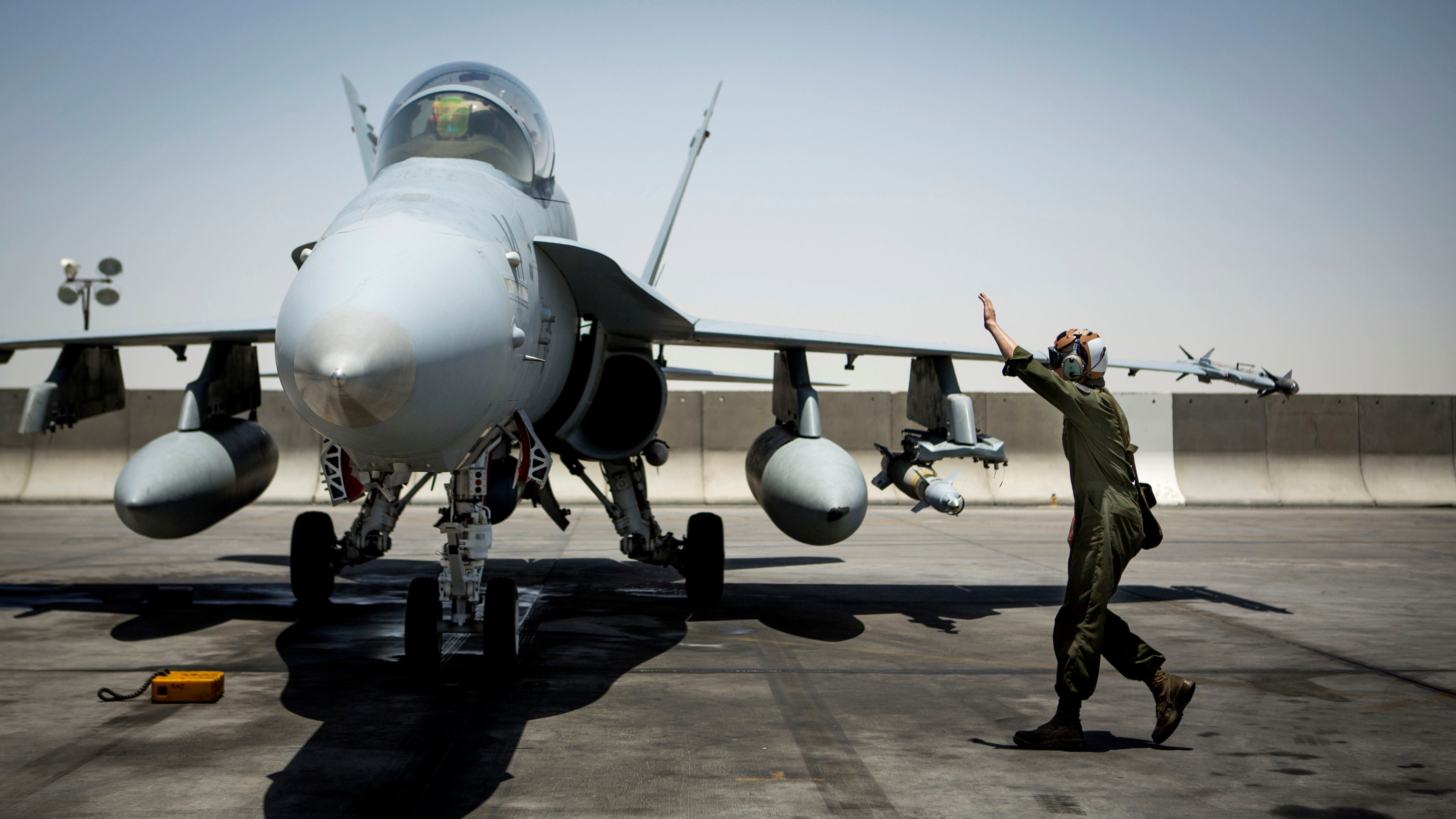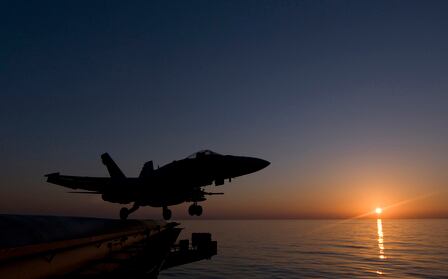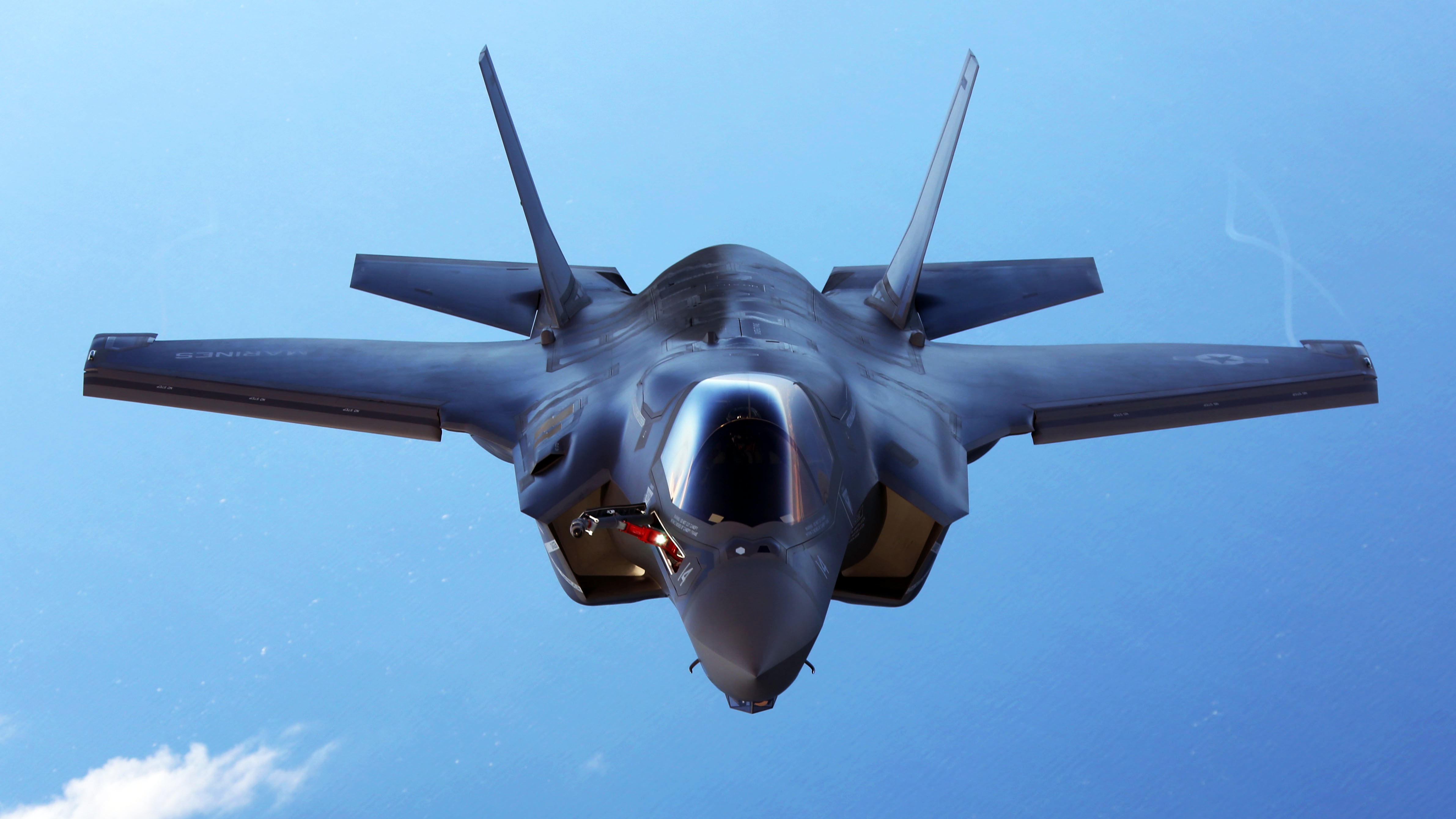With most of its F/A-18 strike fighters Hornets unable to fly on any given day, the Marine Corps is resurrecting 23 Hornets from out of the "boneyard" and getting another seven aircraft from the Navy.
The Marimove comes as both the Marine Corps and Navy are struggle ing to keep enough F/A-18s in the skies Hornets operational until the F-35 joint strike fighter can finally starts to replace the both services’ aging older aircraft.
"We are very focused on our current readiness, and at the moment, we don't have enough Hornets for combat, flight instruction and day-to-day training," said Capt. Sarah Burns, a Marine Corps spokeswoman at the Pentagon.
The Hornet is the first U.S. strike fighter, meaning it can shoot down enemy aircraft, kill bad guys on the ground to support U.S. troops, and bomb enemy targets. The Hornet and the newer F/A-18 E-F Super Hornet were supposed to be phased out in the mid-2020s and 2035 respectively, but delays in the F-35 program have joint strike fighter has forced the Marine Corps and Navy to find ways to keep the aircraft Hornets flying much longer than originally intended.
The 30 F/A-18C Hornets headed back to the fleet are being upgraded to the C+ configuration, Burns said. That means they'll include updates grades to the e C+ modifications include upgrading the Hornet’s flight-deck displays and and installing a joint helmet mounted cueing system, which to gives the pilot more control over the aircraft, according to Boeing.
Each Hornet takes between nine and 18 months to upgrade, depending in the condition of the aircraft. Boeing expects to refurbish 10 Hornets a year starting in 2017.

A Marine with Marine All-Weather Fighter Attack Squadron 533 directs an F/A-18D Hornet returning to an undisclosed location in Southwest Asia, June 9. The squadron conducts strikes on Islamic State group targets during a deployment with Special Purpose Marine Air Ground Task Force-Crisis Response-Central Command.
Photo Credit: Sgt. Donald Holbert/Marine Corps
Most of the Hornets had been were placed in storage at the 309th Aerospace Maintenance and Regeneration Group, commonly known as the "boneyard" at Davis-Monthan Air Force Base, Arizona.
"We purposely housed the aircraft in the 309th Aerospace Maintenance and Regeneration Group ... (AMARG) over the course of a decade with intent to store, maintain and upgrade them for today's use," Burns said in an email.
So far, one of the upgraded Hornets has been delivered to Marine Fighter Attack Squadron 115 based at in Marine Corps Air Station Beaufort, South Carolina, she said. Boeing is making sure a second upgraded Hornet is ready for operational missions while use and work on five more aircraft Hornets is underway.
The C+ modifications include upgrading the Hornet's flight-deck displays and installing a Joint Helmet Mounted Cueing System to give the pilot more control over the aircraft, according to Boeing. Each Hornet takes between nine and 18 months to upgrade, depending in the condition of the aircraft. Boeing expects to refurbish 10 Hornets a year starting in 2017.
'Mothball' planes
Experts are divided about the efficacy of returning Hornets from the boneyard to service.
It is common practice for the military to "mothball" planes, ships and vehicles since because when the services contract, they often end up with more usable equipment than they need, said retired Marine Lt. Col. Dakota Wood, a senior research fellow at the Heritage Foundation think tank in Washington, D.C.
"When this happens, it makes sense to place the items in long-term storage to avoid both the maintenance costs of keeping the equipment in ready-to-use condition and wasting taxpayer dollars by destroying equipment that still has useful life," Wood told Marine Corps Times. "Resurrecting older equipment also mitigates the costs in time and money of building new items unless the old item has truly become obsolete relative to threats and missions it was originally designed to handle."

An F/A-18C Hornet launches from an aircraft carrier during a deployment to the Middle East. The Marine Corps and Navy are using Hornets to strike Islamic State group targets.
Photo Credit: MC3 Timothy A. Hazel/Navy
In February 2015, the B-52H "Ghost Rider" took off from Davis-Monthan for Barksdale Air Force Base, Louisiana, after spending seven years in the boneyard. The Air Force decided to restore the bomber to replace another B-52 damaged in a fire the year prior before.
But while the Hornets in the boneyard can be inspected, repaired and returned to full mission-capable status, doing so can be technically risky and expensive, said retired Navy Cmdr. Chris Harmer, senior naval analyst at the Institute for the Study of War.
"After sitting in the desert for a decade, nobody really knows what condition they are in until they get to the depot-level maintenance facility and are opened up and inspected" Harmer said.
Marine Corps aviation is "on the verge of systemic failure" because the fleet has been overused since Sept. 11, 2001, Harmer added, and the F-35s that will ultimately replace current aircraft are years behind schedule, Harmer said.
"This is not the fault of the Marine Corps, but the Marines will pay the price for it through excess pilot mortality, and the U.S. will face a significant strategic risk in the near future if deployable Marine tactical aviation suffers a significant decrease in availability, which now seems inevitable," he said.
The readiness challenges facing the Marine Corps are common to all of the military services, which o have to meet a constant or increasing operational s tempo with less money, a Ccongressional staffer, who spoke on the condition of anonymity, told Marine Corps Times. As a result, the Marine Corps is using its aircraft far more than it ever intended to, so the Hornets in the boneyard may have fewer flight hours than F/A-18s being used now.
Readiness for the military overall is "in crisis," said Rep. Rob Wittman, chairman of the House Armed Services Readiness Subcommittee, which will hold a hearing in July about the extent of aviation readiness gaps and how to fix them.
"The Marine Corps has been unequivocal about the aviation readiness challenges it faces," said Wittman, a Virginia Republican R-Va. "They’ve said that they don’t have the number of Hornets they need for combat, flight instruction, and training.
"That means we are scraping aircraft together to fly combat operations today at the expense of future generations of Hornet pilots. This is just one example of how our readiness shortfalls are compromising our national security and, unfortunately, it is not limited to the Hornet or the Marine Corps."
Skipping a generation
As of late April, only 87 of the Marine Corps' fleet of 276 Hornets were flyable, Marine Corps officials told Congress. Many planes are grounded due to a lack of spare parts and other maintenance issues.
Hornets require heavy a lot of maintenance because of their age and how often they are used, but steep across-the-board budget cuts known as "sequestration" created a backlog of aircraft in depot because there wasn’t enough money to do preventative maintenance on aircraft or replace artisans who retired or took another job, officials said.
The Marine Corps does not expect to dig itself out of its aviation readiness hole until 2020.
Some have suggested that the Marine Corps should have purchased newer F/A-18E and F Super Hornets as a stopgap measure, but that would have slowed the service’s procurement of F-35s, putting even more stress on its Hornets and AV-8B Harriers, said Jesse Sloman, an analyst with the Center for Strategic and Budgetary Assessments think tank in Washington, D.C.
"The Corps is in a bind right now because of the service's decision to skip a generation of fighter aircraft by going directly from the legacy Hornet to the joint strike fighter, Sloman said. "This risky choice has led to some short-term pain due to the brittleness of the F/A-18 and the negative impacts of the 2011 sequestration."

An F-35B joint strike fighter jet conducts aerial maneuvers during refueling training over the Atlantic Ocean last summer.
Photo Credit: Cpl. Neysa Huertas Quinones/Marine Corps
But the Marine Corps' aggressive plan to switch to the F-35 should allow the service to phase out its current aircraft quickly rather than spending money to keep less capable planes flying longer, he said.
Meanwhile, the Navy had a shortfall of 104 strike fighters last year — and that number could grow to 134 aircraft by 2020, then-Chief of Naval Operations Adm. Jon Greenert told Congress in March 2015.
That’s why the Navy is upgrading its fleet of F/A-18s, so that the Hornets will continue to make up the majority of carrier aircraft through the end of the 2020s. The Hornets had been designed to fly up to 6,000 hours, but with delays in the F-35 program, the Navy officials hopes the F/A-18s will be able to fly up to 10,000 hours — or more.
"We might even fly [Super Hornets until]these airplanes close to 2040," Rear Adm. Mike Manazir, the Navy's air warfare director, told the House Armed Services subcommittee on seapower in November.




